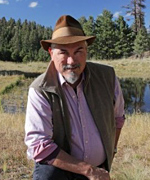 —by Alan Dulaney
—by Alan Dulaney
Three sectors sharing Colorado River water. Three lines in the sand. And nothing in the middle that looks like a viable compromise. Arizona is in trouble.
On October 25, ADWR and CAWCD cancelled the scheduled meeting of the Lower Basin Drought Contingency Plan (LBDCP) Steering Committee with only a few hours notice. It was obvious that something had gone badly wrong, but specifics were kept quiet. In the CAWCD Board of Directors meeting on November 1, it became clear what the specifics were (which is why electing the right people to that Board is important). All centered on the mitigation proposals to deal with harsher cuts in deliveries under the LBDCP, primarily to Pinal County irrigators. All were based on more or less intransigent positions from the three major sectors that receive water from the CAP canal: agricultural, tribal, and municipal.
First came a letter from the Gila River Indian Community on October 19. Two basic principles were enunciated:
- No CAP user should emerge with more water under LBDCP than they would have had under the existing 2007 shortage guidelines
- No mitigation plan can be approved that does not provide for equitable mitigation to the Non-Indian Agricultural pool.
Their first point revolved around the realization that the calculation of the Pinal County agricultural mitigation proposal was based on outdated 2015 CAP orders, not 2019 numbers, which cut the needed mitigation amount significantly. The letter also noted that the tribes under no circumstances would agree to giving up their water rights under LBDCP, including their ability to create Intentionally Created Surplus on Lake Mead. Indeed, GRIC emphasized that the main purpose of LBDCP was to leave water on Lake Mead, and a robust system conservation program should be at the heart of any Arizona adoption of LBDCP.
Next came a letter from the Arizona Municipal Water Users Association on October 25. The AMWUA letter agreed that LBDCP should be adopted and that earlier and harsher cuts to Colorado River supplies than originally envisioned under the 2007 guidelines would be necessary. AMWUA noted that municipalities with NIA water face significant cuts under LBDCP and should be able to maximize use of that water while it is still available. After all, they paid for it. And even if it means killing LBDCP support, AMWUA will unequivocally oppose any attempt to restrict the ability of municipal providers to manage their CAP water for the benefit of the ratepayers, including recharging that water today in order to secure their economic future tomorrow. (Read the municipal position here.)
Finally, the CAWCD Board of Directors heard that Pinal County agricultural districts had collectively passed motions that essentially demanded full mitigation of 595,000 acre-feet over 7 years, regardless of further declines in Lake Mead water level elevations, or no support for LBDCP in the Legislature. Also, Representative David Cook of Pinal County sent a letter to Governor Ducey in support of Pinal County agriculture. His central theme was that agriculture is big business, essential for Arizona, and cannot be allowed to fail. He questioned why cities should be allowed to store water for an unknown purpose tomorrow when farmers need that water today. And he reiterated the full mitigation demand for 595,000 acre-feet of water over 7 years.
The LBDCP will not prevent a declaration of a Tier 1 shortage on the Colorado River in 2020; that now seems baked in. But the harsher cuts of LBDCP will forestall a dive into a Tier 2 or Tier 3 shortage in 2021 and later, and thus prevent a system collapse that would deprive all sectors of major amounts of CAP water. Regardless of drought conditions, the structural deficit still remains on Lake Mead. The GRIC letter had it right: only intense system conservation will stabilize Lake Mead water level elevations and preserve the CAP system, and that means cutting demand.
Three lines in the sand. Three positions from three sectors, with no real overlap. Nothing in the middle, in the common ground between the sectors that is the Arizona economy. Everyone is ready to walk out. Gaining the approval of the Legislature so that adoption of LBDCP could occur remains essential, and everyone knows it. But the Steering Committee process looks like it could collapse at any minute. Someone had better come up soon with a compromise, and all sectors had better sign on — time is running out. Intransigence is not a survival trait here. Only through collaboration and cooperation can a politically acceptable solution be crafted, such that Arizona can join the rest of the Basin states in approving the Drought Contingency Plan. Save the water, save the state.